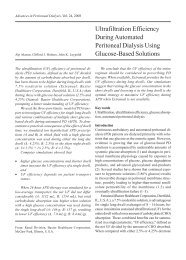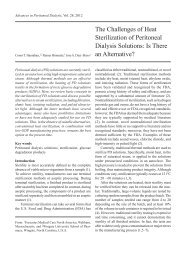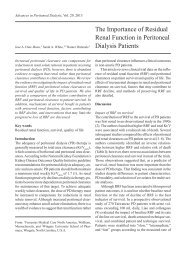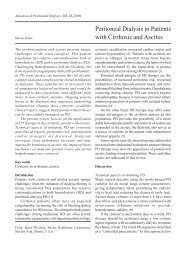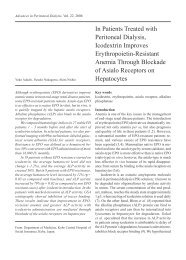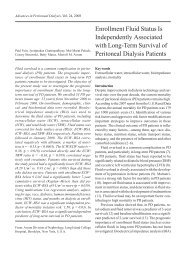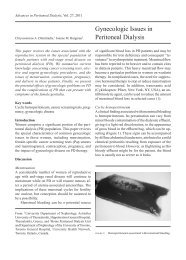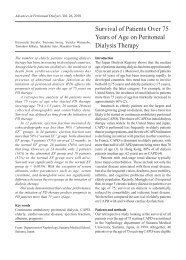Combined Amino-Acid and Glucose Peritoneal Dialysis Solution for ...
Combined Amino-Acid and Glucose Peritoneal Dialysis Solution for ...
Combined Amino-Acid and Glucose Peritoneal Dialysis Solution for ...
- No tags were found...
Create successful ePaper yourself
Turn your PDF publications into a flip-book with our unique Google optimized e-Paper software.
Body Composition in Children on PD(8), but no attempt was made to define a maximumKt/V value in our patients.<strong>Peritoneal</strong> equilibration testThe PET was per<strong>for</strong>med according to a previouslypublished protocol (9,10). Briefly, a st<strong>and</strong>ardized volume(1100 mL/m 2 body surface area) of Dianeal 2.5%solution (Baxter Healthcare SA, Castlebar, Irel<strong>and</strong>)was instilled into the peritoneal cavity, <strong>and</strong> dialysatesamples were taken from the overnight exchange bagat 0, 120, <strong>and</strong> 240 minutes. A serum sample was takenat 120 minutes. Results were analyzed <strong>for</strong> the dialysate-to-plasma(D/P) creatinine <strong>and</strong> final-to-initialdialysate (D/D 0) glucose equilibration ratios at 4 hours,<strong>and</strong> each patient was categorized as a high, highaverage,low-average, or low transporter accordingto pediatric values published by Warady et al. (9).Biochemical measurementsWe obtained plasma measurements of bicarbonate(mEq/L, by bromcresol blue), phosphate (mg/dL, byphosphomolybdate complex colorimetry at 340 nm),calcium (by the cresolphthalein complexone method),alkaline phosphatase (by 4-nitrophenyl phosphate),<strong>and</strong> hemoglobin (by cyanmethemoglobin).Statistical analysisMeans, st<strong>and</strong>ard deviations, correlation coefficients,<strong>and</strong> t-tests were per<strong>for</strong>med using Excel 5.0 (MicrosoftCorporation) <strong>and</strong> Statistica <strong>for</strong> Windows, version 4.5(StatSoft, Tulsa, OK, U.S.A.). Values of p < 0.05 wereaccepted as statistically significant.ResultsBody compositionBetween the start of the protocol <strong>and</strong> month 6, the20 patients evaluated by DEXA showed an increasein BMD to 0.769 ± 0.174 g/cm 2 from 0.747 ± 0.166 g/cm 2 , p < 0.05. The BMC in the group also increasedto 680.3 ± 666.1 g from 632.6 ± 597.5 g, p < 0.01.The mean BMD Z score at the beginning of thestudy in patients older than 4 years (n = 11) was –0.69(range: 0.3 to –2.2). The mean BMD Z score <strong>for</strong> those11 patients showed a significant increase to –0.35 atmonth 6. The FBM <strong>and</strong> FFM also increased, but withoutreaching statistical significance.The patients’ DPI showed a negative correlationwith BMD, BMC, <strong>and</strong> FFM (p < 0.05; Table I).233AnthropometryThe mean Z score <strong>for</strong> height/age was –2.17 (range:–4.75 to –0.3) at the start of the study, <strong>and</strong> –2.14 (range:–3.98 to –0.2) at month 6 [p = nonsignificant (NS)].The Z score <strong>for</strong> weight/age was –1.6 (range: –3.15 to–0.39) <strong>and</strong> –1.94 (range: –2.25 to 0.39) at the sametime periods (also p = NS).Dietary intakeMost of the patients showed a caloric intake abovethe RDA recommendations (mean values: 115.11% ±37.21% at month 1 <strong>and</strong> 108.16% ± 35.84% atmonth 6). In addition, the patients’ DPI exceeded theDOQI (5) recommendations (mean values: 144.77% ±48.74% at month 1 <strong>and</strong> 140.85% ± 52.13% atmonth 6, p = NS). Table II shows other dietary intakevalues.The patients’ mean DPI was 3.32 ± 1.6 g/kg/dayat the beginning of the study <strong>and</strong> 3.3 ± 1.3 g/kg/dayat month 6 (p = NS). A comparison of DPI versus bicarbonateshowed a negative correlation at the beginningof the study (r = –0.46, p < 0.05), but only atendency toward a negative correlation at month 6.Nitrogen balance studiesAll patients showed a positive NB initially <strong>and</strong> atmonth 6 of follow-up. Initially, mean DPI was 3.32 ±1.05 g/kg/day, <strong>and</strong> mean daily protein losses were1.19 ± 0.47 g/kg/day, <strong>for</strong> a mean net protein balanceof +2.1 g/kg/day. At month 6 of the study, mean DPIwas 3.30 ± 1.7 g/kg/day, <strong>and</strong> mean daily protein losseswere 1.7 ± 0.47 g/kg/day, <strong>for</strong> a net protein balance of+1.6 g/kg/day. We observed no difference in the proteinbalance between month 1 <strong>and</strong> month 6 of thestudy. We found a negative correlation between BN<strong>and</strong> the parameters BMD, FBM, <strong>and</strong> FFM (r = –0.8,r = –0.55, <strong>and</strong> r = –0.7 respectively; p < 0.05).<strong>Dialysis</strong> doseThe mean weekly total Kt/V urea was 3.31 ± 1.1 atthe beginning of the study <strong>and</strong> 2.57 ± 1.53 at month 6.The mean weekly peritoneal <strong>and</strong> residual Kt/V ureavalues were, respectively, 1.7 ± 0.81 <strong>and</strong> 1.5 ± 1.24 atthe beginning of the study, <strong>and</strong> 1.6 ± 0.58 <strong>and</strong> 1.5 ±1.18 at month 6.<strong>Peritoneal</strong> equilibration testThe mean 4-hour D/P creatinine was 0.78 ± 0.02 initially<strong>and</strong> 0.74 ± 0.13 at month 6 (p = NS). The mean



